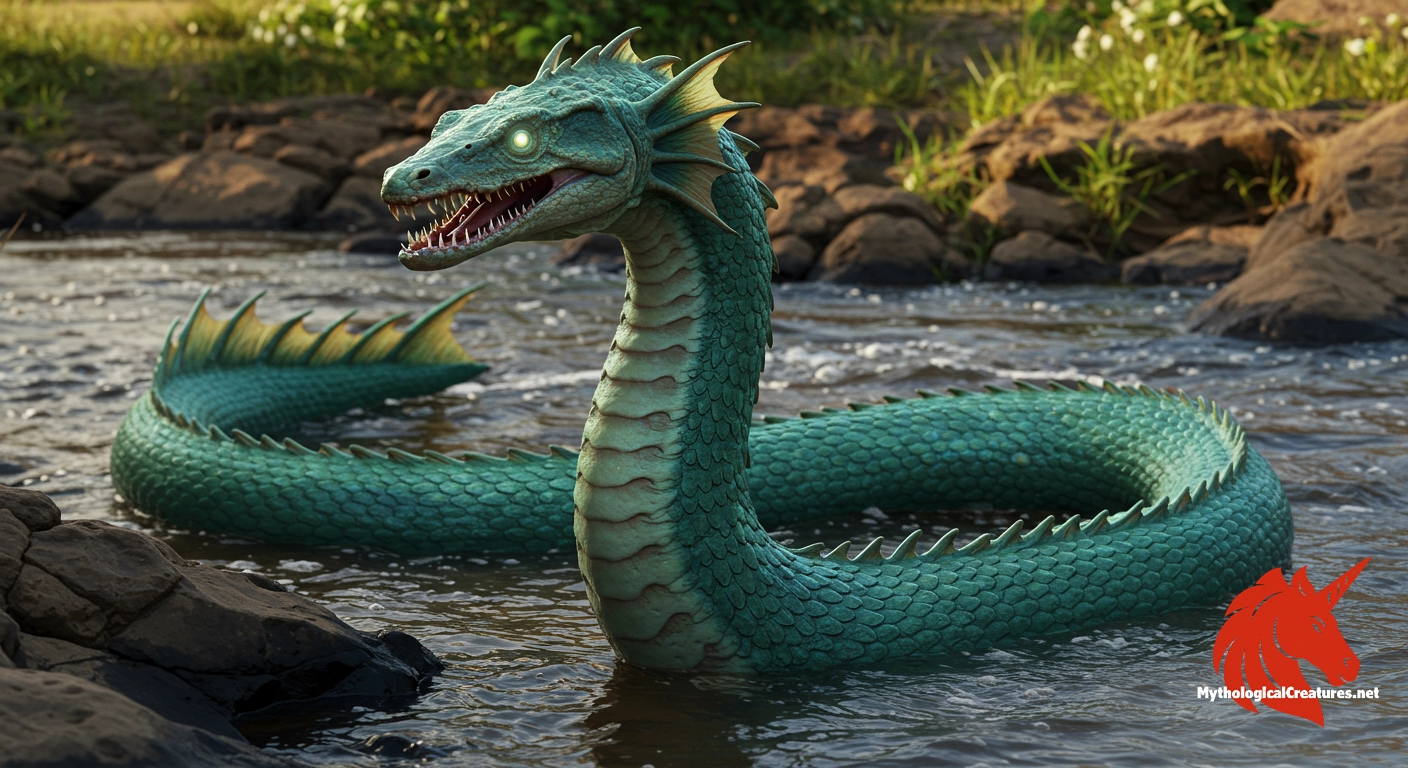Nyami Nyami: Nyami Nyami is the revered river deity of the Zambezi, depicted as a hybrid creature with the body of a snake and the head of a fish.

Nyami Nyami
Nyami Nyami - Nyami Nyami plays a crucial role in explaining natural events such as floods and in sustaining the people of the Zambezi Valley.
Origins & First Encounters
Nyami Nyami, often known as the Zambezi River God, is a figure steeped in ancient mystery and local reverence along the banks of the mighty Zambezi. Born from the rich tapestry of oral tradition, his myth emerges from pre-colonial narratives and continues to hold a central place in the spiritual lives of local communities. His presence is interwoven with the everyday survival of the people, providing both protection and sustenance in times of hardship. Many accounts describe him as a powerful guardian who embodies the vitality and unpredictability of the river. The deity is traditionally viewed as male, with a persona that exudes both benevolence and formidable force. His image has been preserved in myriad forms—from intricately carved pendants and walking sticks to subtle artistic motifs in local craft. Local legends sustain his role as not only a natural custodian but also as a divine intermediary between the earthly realm and the unseen. The enduring power of his narrative reflects the intimate bond between the communities and the lifegiving waters of the Zambezi. Even today, the myth of Nyami Nyami continues to inspire both devotion and respect, symbolising the ever-present connection between people and nature.
Source Texts & Tale Variants
Oral tradition forms the core of Nyami Nyami’s legend, with stories passed down through generations of elders and spirit mediums. Although ancient texts remain sparse, early accounts recorded during colonial encounters hint at a deep-rooted belief in the river deity. Varied renditions tell of a god capable of both nurturing life and unleashing devastating retribution during times of natural upheaval. Some narratives focus on his role as a guardian who ensures sustenance for the valley’s inhabitants, while others highlight episodes of his anger when the natural order is disrupted. Several versions of the myth include the poignant tale of his separation from his wife, a narrative that adds an emotional depth to his divine character. Rituals and traditional ceremonies frequently invoke his name, with parts of the mythology adapted over time as circumstances and environmental challenges evolved. Variations in the retelling reveal a dynamic myth, one that shifts subtly with each successive generation. Folk performances and local storytelling have kept the essence of his legend alive, even as modern influences percolate into traditional culture. In essence, the multiplicity of these sources underscores Nyami Nyami’s complex role as both protector and unpredictable force of nature.
Form & Powers
Descriptions of Nyami Nyami offer a rich visual tableau that mixes the elements of the aquatic and the serpentine. He is typically depicted as having the elongated, sinuous body of a snake combined with a distinctly fish-like head, creating a creature that is as enigmatic as it is powerful. The deity’s form is rendered with graceful curves that mimic the undulating motion of river waters, lending him an almost liquid dynamism. His scales are often portrayed as shimmering and reflective, suggesting the glint of sunlight on flowing water. Artistic depictions give special attention to his eyes, which are said to be profound pools that mirror the secrets of the river’s depths. The body of Nyami Nyami is sometimes illustrated with intricate, swirling patterns, reinforcing the association with water currents and whirlpools. Variability in his size and form exists among different artistic traditions, with some communities portraying him as an immense, awe-inspiring force of nature. Carvings in materials such as wood, stone, bone, and even precious metals, capture his dual nature—both a creative guardian and an awe-inducing presence. The detailed physical portrayals serve not only as symbols of divine power but also as reflections of the deep cultural and environmental connections nurtured over generations. Each representation, whether humble or elaborate, memorialises the dynamic and mutable spirit that Nyami Nyami embodies.
Regional Faces
The myth of Nyami Nyami exhibits fascinating regional variations that mirror the diverse cultural landscapes along the Zambezi. In some localities, he is portrayed strictly as the benevolent protector of life, while in others, the emphasis is more on his fearsome ability to unleash nature’s fury. Communities in distinct areas, particularly those in Zambia and Zimbabwe, infuse the god’s image with unique contextual details that reflect their local environment. In certain regions the deity’s image is closely tied to specific landmarks such as the Kariba Gorge, which in turn colours the narrative with local geographical importance. Regional artisans imbue his carvings with stylistic nuances that differ from one village to the next, resulting in a vibrant mosaic of artistic expression. Local rituals designed to appease his temper or celebrate his gift of life illustrate the integration of the divine into everyday community life. Differences in environmental experiences—ranging from seasonal floods to droughts—have led to variations in the way his dual nature is interpreted. These regional adaptations serve to keep the myth dynamic, allowing communities to engage with and reinterpret the legend as they face new challenges. The variations not only highlight local identities but also reinforce a collective reverence for nature’s vital forces. Ultimately, the regional diversity of the myth speaks to the adaptability and resilience of its cultural roots.
Cultural Parallels
Drawing parallels between Nyami Nyami and deities from other cultural traditions reveals striking similarities in theme and symbolism. Like the revered water dragons of East Asia or ancient river gods from Mesopotamian lore, Nyami Nyami embodies the dual nature of water as both a life-giving and destructive force. His multi-faceted role as a nurturer and an executor of nature’s retribution is echoed in various mythologies around the world. The imagery used to depict him—a sinuous form intertwined with water elements—resonates with depictions of serpents and dragons in diverse cultural contexts. Similar to the Yoruba water deities, his legend underscores a deep respect for the mysteries of aquatic life and the unpredictability of nature. The use of tangible objects like pendants and ritual paraphernalia to invoke his presence is common in many global traditions where physical tokens serve as conduits for divine protection. Just as natural phenomena have inspired the creation of folklore across continents, Nyami Nyami’s story reinforces humanity’s longstanding effort to personalise and understand the elemental forces. Comparative analysis shows that deities linked to water often serve as metaphors for life’s perpetual cycle of birth, death, and renewal. The universal motif of a powerful, enigmatic river spirit reinforces a shared human fascination with and reverence for the forces of nature. In this way, Nyami Nyami sits comfortably within a broader mythological framework that transcends regional boundaries yet is uniquely tailored to the Zambezi’s mystique.
Legacy & Modern Evolution
The evolution of Nyami Nyami’s myth reflects a profound transformation shaped by historical events and modern reinterpretations. Once revered solely as a divine guardian linked to the bounty and perils of the river, his image has grown to encapsulate broader themes of environmental stewardship and cultural identity. The construction of the Kariba Dam, an event that brought both progress and tragedy, deeply influenced his narrative by transforming him into a symbol of nature’s displeasure and the disruption of ancient harmony. Contemporary artistic expressions have embraced this layered history, melding traditional motifs with modern aesthetics to capture his enduring spirit. His image now appears in a variety of contexts, ranging from local artisanal crafts to global media representations, each reflecting an evolving dialogue between tradition and modernity. Festivals, rituals, and even environmental campaigns invoke his name as a reminder of the delicate balance between human endeavour and nature’s autonomy. Nyami Nyami continues to inspire admiration and caution, serving as an emblem of the resilience of natural forces in the face of technological change. As communities navigate the challenges of environmental degradation and cultural dilution, his myth remains a potent symbol of hope and continuity. The legacy of Nyami Nyami is celebrated not only as a historical entity but also as a dynamic force that adapts to modern needs and sensibilities. In bridging ancient wisdom with contemporary concerns, his story endures as a testament to the timeless relationship between humanity and the natural world.
Interesting Fact
Nyami Nyami’s image has transcended its traditional cultural context, inspiring modern art and serving as a symbol of heritage and environmental reverence in Zambia.
Quick Creature Info
Origin:
Associations:
Our Mythic Legendary Rating:

Also Sometimes Known As:
Habitat:
Supernatural Powers:
Physical Attributes:
Abilities:
Behavior:
Lore:
Related Creatures, Tales or Lore
References
Discover Another Mythical Legend You May Not Have Heard Of?
Uncover the mysteries of ancient folklore and expand your knowledge of legendary beings from cultures around the world.
Dare to Meet the Epiur....
Curated by the Mythological Creatures Team (rev. May 2025)
